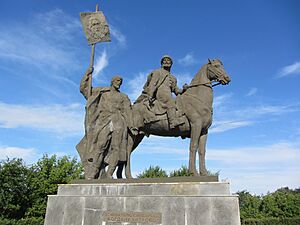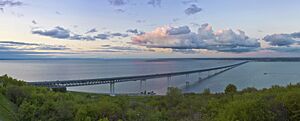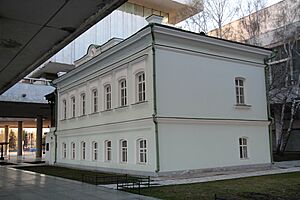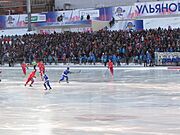Ulyanovsk facts for kids
Quick facts for kids Ulyanovsk (English)Ульяновск (Russian) |
|
|---|---|
| - City - | |
 View of Ulyanovsk, now dominated by Soviet-era buildings |
|
|
|
|
| City Day | June 12 |
| Administrative status | |
| Country | Russia |
| Federal subject | Ulyanovsk Oblast |
| Administratively subordinated to | city of oblast significance of Ulyanovsk |
| Municipal status | |
| Urban okrug | Ulyanovsk Urban Okrug |
| Administrative center of | Ulyanovsk Urban Okrug |
| Head | Dmitry Zverev (Acting) |
| Representative body | City Duma |
| Statistics | |
| Area | 316.9 km2 (122.4 sq mi) |
| Population (2010 Census, preliminary) |
613,786 inhabitants |
| - Rank in 2010 | 20th |
| Density | 1,937/km2 (5,017/sq mi) |
| Time zone | MSK (UTC+04:00) |
| Founded | 1648 |
| City status since | 1796 |
| Previous names | Simbirsk |
| Postal code(s) | 432xxx |
| Dialing code(s) | +7 8422 |
| Official website: http://www.ulmeria.ru/ | |
Ulyanovsk, known as Simbirsk until 1924, is a large city in Russia. It is the main city of Ulyanovsk Oblast. You can find it on the Volga River, about 705 kilometers (438 mi) east of Moscow. Since 2015, Ulyanovsk has been the only Russian UNESCO City of Literature. This means it's recognized for its strong literary history.
The city is famous as the birthplace of Vladimir Lenin. He was born Vladimir Ulyanov, and the city was renamed after him in 1924. Another important person born here was Alexander Kerensky. He led the government that Lenin later overthrew in 1917. Many famous writers like Ivan Goncharov and Nikolay Karamzin also came from Ulyanovsk.
Contents
History of Ulyanovsk
Founding and Early Years
Simbirsk was started in 1648 by a nobleman named Bogdan Khitrovo. He built a fort called "Simbirsk" on a hill next to the Volga River. This fort was important for protecting the eastern border of Tsardom of Russia (the old Russian kingdom). It also helped Russia show its power in the area.
In 1668, Simbirsk faced a big challenge. A rebel army of 20,000 led by Stenka Razin tried to capture it. But the city held strong for a month. Later, another rebel leader, Yemelyan Pugachev, was held prisoner here before his execution. The old wooden fort was destroyed by fire in the 1700s.
Growth and Renaming
As Russia expanded eastward into Siberia, Simbirsk became less important for defense. However, it grew into a key regional center. In 1796, it officially became a city.
Simbirsk was known as a fancy town where rich families lived. It had churches, a Governor's Place, and a grand library. The Holy Trinity Cathedral was built between 1827 and 1841. In 1864, a big fire destroyed most of Simbirsk. But the city was quickly rebuilt and kept growing. Its population increased from 26,000 in 1856 to 43,000 by 1897.
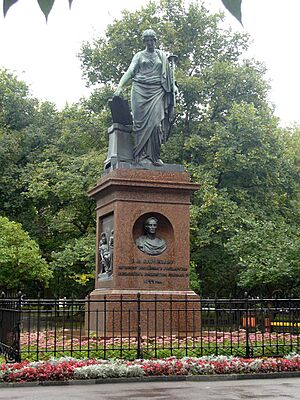
In 1924, the city's name changed to Ulyanovsk. This was to honor Vladimir Lenin, who was born there in 1870. His real name was Vladimir Ulyanov.
Modern Developments
In 1957, a large hydroelectric plant was built downstream from Ulyanovsk. This caused the Volga River to become much wider, up to 35 kilometers (22 mi) in some places. Some parts of Ulyanovsk are now below the water level of the reservoir. They are protected by a dam.
During the Soviet era, Ulyanovsk was a popular place for tourists. People came from all over Russia to see Lenin's birthplace. After the dissolution of the Soviet Union in the 1990s, tourism decreased. The city faced tough times with job losses and economic problems. But in the 2000s, the economy started to improve. Ulyanovsk has slowly become an important center for manufacturing, education, and transportation.
Population and People
Ulyanovsk is home to many people. In 2008, there were 6,774 births and 8,054 deaths.
Ethnic Groups
The city has a diverse population:
Climate and Weather
Ulyanovsk has a climate with warm summers and cold winters. The average temperature in February is −10.2 °C (13.6 °F). In July, it's 20.6 °C (69.1 °F). Snow usually starts in mid-November. Winters can be very cold, sometimes dropping below −25 °C (−13 °F). Summers arrive in mid-May and are sunny. The city gets about 480 millimeters (19 in) of rain each year.
| Climate data for Ulyanovsk (1991–2020, extremes 1948–present) | |||||||||||||
|---|---|---|---|---|---|---|---|---|---|---|---|---|---|
| Month | Jan | Feb | Mar | Apr | May | Jun | Jul | Aug | Sep | Oct | Nov | Dec | Year |
| Record high °C (°F) | 5.6 (42.1) |
5.6 (42.1) |
19.4 (66.9) |
30.0 (86.0) |
36.2 (97.2) |
37.5 (99.5) |
38.9 (102.0) |
39.3 (102.7) |
33.9 (93.0) |
26.0 (78.8) |
15.8 (60.4) |
7.8 (46.0) |
39.3 (102.7) |
| Mean daily maximum °C (°F) | −6.5 (20.3) |
−5.9 (21.4) |
0.8 (33.4) |
12.1 (53.8) |
21.0 (69.8) |
24.8 (76.6) |
26.9 (80.4) |
25.1 (77.2) |
18.3 (64.9) |
9.9 (49.8) |
0.6 (33.1) |
−5.2 (22.6) |
10.2 (50.4) |
| Daily mean °C (°F) | −9.8 (14.4) |
−10.2 (13.6) |
−3.8 (25.2) |
6.1 (43.0) |
14.4 (57.9) |
18.5 (65.3) |
20.6 (69.1) |
18.5 (65.3) |
12.5 (54.5) |
5.6 (42.1) |
−2.1 (28.2) |
−8.0 (17.6) |
5.2 (41.4) |
| Mean daily minimum °C (°F) | −13.1 (8.4) |
−14.0 (6.8) |
−7.9 (17.8) |
0.9 (33.6) |
7.8 (46.0) |
12.2 (54.0) |
14.4 (57.9) |
12.4 (54.3) |
7.6 (45.7) |
1.9 (35.4) |
−4.6 (23.7) |
−10.8 (12.6) |
0.6 (33.1) |
| Record low °C (°F) | −38.0 (−36.4) |
−40.0 (−40.0) |
−32.8 (−27.0) |
−20.0 (−4.0) |
−6.5 (20.3) |
−2.2 (28.0) |
3.8 (38.8) |
−1.0 (30.2) |
−4.9 (23.2) |
−18.9 (−2.0) |
−29.2 (−20.6) |
−38.0 (−36.4) |
−40.0 (−40.0) |
| Average precipitation mm (inches) | 35 (1.4) |
25 (1.0) |
27 (1.1) |
30 (1.2) |
44 (1.7) |
57 (2.2) |
50 (2.0) |
50 (2.0) |
45 (1.8) |
39 (1.5) |
32 (1.3) |
31 (1.2) |
465 (18.3) |
| Average extreme snow depth cm (inches) | 27 (11) |
41 (16) |
38 (15) |
6 (2.4) |
0 (0) |
0 (0) |
0 (0) |
0 (0) |
0 (0) |
0 (0) |
3 (1.2) |
15 (5.9) |
41 (16) |
| Average rainy days | 4 | 3 | 5 | 11 | 15 | 16 | 15 | 15 | 15 | 16 | 10 | 5 | 130 |
| Average snowy days | 23 | 20 | 14 | 4 | 1 | 0 | 0 | 0 | 0.3 | 5 | 16 | 21 | 104 |
| Average relative humidity (%) | 83 | 81 | 79 | 67 | 59 | 67 | 68 | 70 | 73 | 79 | 84 | 84 | 75 |
| Mean monthly sunshine hours | 43.4 | 92.4 | 142.6 | 216.0 | 275.9 | 300.0 | 319.3 | 275.9 | 174.0 | 102.3 | 48.0 | 37.2 | 2,027 |
| Source 1: Pogoda.ru.net | |||||||||||||
| Source 2: Climatebase (sun only) | |||||||||||||
Economy and Industry
Ulyanovsk is a big center for different industries. It's especially known for making aircraft and cars.
Many important factories are located here:
- The UAZ plant makes cars.
- Aviastar-SP builds airplanes.
- "Mars" makes control systems for the Russian Navy.
- Ulyanovsk Cartridge Works produces ammunition.
- Ulyanovsk Motor Plant (UMZ) and Ulyanovsk Mechanical Plant (UMZ) are also here.
Volga-Dnepr Airlines, an international airline that carries very large cargo, is based in Ulyanovsk. Many foreign companies like Mars, Incorporated also have factories in the city. Ulyanovsk also has a strong military presence, including the 31st Airborne Brigade.
Tourism and Hospitality

Tourism is growing in Ulyanovsk. The Volga River and the city's history make it a good place to visit. Big hotel chains like Hilton and Marriott are building new hotels.
The Undory region near Ulyanovsk is famous for its spas and mineral water. The city also offers many sports activities. The countryside is great for outdoor and water sports.
Transportation and Travel
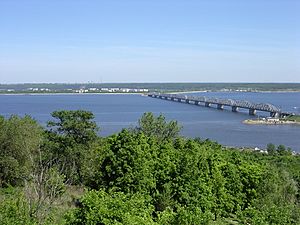
A railway bridge was built across the Volga River between 1912 and 1916. Later, car lanes were added to it. This helped the city grow on both sides of the river. Ulyanovsk became an important transport hub.
Ulyanovsk is in a good location in European Russia. It has air, rail, road, and river routes. This helps it become a major transport and logistics center. The city has a busy river port, two main railway stations, and two airports. It also has two major bridges.
The old Ulyanovsk bridge was the only way to cross the Volga for 400 kilometers (250 mi). It couldn't handle all the traffic. So, construction of the President Bridge started in the late 1980s. It was officially opened in 2009 by the Russian President Dmitry Medvedev. This bridge is 5.5 kilometers (3.4 mi) long, making it one of the longest in Europe.
The city is also divided by the Sviyaga River. This river flows into the Volga about 200 kilometers (120 mi) north of the city.
Ulyanovsk has a good public transport system. It includes tram lines, trolleybus routes, and many bus and taxi lines. The city plans to build a high-speed rail system to connect its two sides.
Ulyanovsk has two airports:
- Ulyanovsk Vostochny Airport (international flights)
- Ulyanovsk Baratayevka Airport (Ulyanovsk Central Airport, mainly for domestic flights)
Education and Learning
Ulyanovsk has several important universities and colleges:
- Ulyanovsk State University: Started in 1988, it's one of the biggest universities in the Volga region. It has many institutes and faculties. About 15,000 students study here each year.
- Ulyanovsk State Technical University: Founded in 1957, it has over 14,000 students.
- Ulyanovsk State Pedagogical University: Established in 1932, it trains teachers.
- Ulyanovsk State Agricultural Academy: Started in 1943, it focuses on agriculture.
- Ulyanovsk Higher Civil Aviation School: Founded in 1935, it trains pilots and flight crews. It also has a museum about civil aviation history.
There are also many technical and medical colleges in Ulyanovsk.
Architecture and Landmarks
During the Soviet era, Ulyanovsk lost many old buildings. The original wooden fort is gone, and so are many old churches. However, many 19th-century buildings still stand. These include the houses where Lenin lived.
Ulyanovsk has several places for tourists to visit. The "Lenin`s hometown" historical complex is a major attraction. It shows what life was like in Russia in the late 1800s and early 1900s. This complex was founded in 1984 and has 14 museums.
Sports and Activities
Ulyanovsk is a city that loves sports!
- The Volga team plays in Russia's top Bandy league.
- The Volga-Sport-Arena is an indoor arena for bandy. It opened in 2014 and can hold 5,000 people.
- Ulyanovsk hosted the Bandy World Championship 2016. It will also host the Youth-17 Bandy World Championship in 2018.
- In football, FC Volga plays in the "Urals-Volga" zone of the Russian Second Division.
- The city also hosted matches for the UEFA Women's Under-17 Championship 2014. These games were held at Trud Stadium.
- In 2017, Ulyanovsk held the first festival for national sports from the CIS. Sports included sambo, tug of war, and chess.
Famous People from Ulyanovsk
Many notable people were born or lived in Ulyanovsk:
- Vladimir Lenin (1870–1924): A key figure in Russian history, a revolutionary and the first leader of the Soviet Union.
- Ilya Ulyanov (1831–1886): Lenin's father, known for his work in public education.
- Ivan Goncharov (1812–1891): A famous novelist, author of "Oblomov".
- Nikolay Karamzin (1766–1826): A writer, poet, and historian.
- Alexander Kerensky (1881–1970): A political leader who was Prime Minister of Russia before Lenin took power.
- Ludmila Belousova (1935–2017): A figure skater who won two Winter Olympic championships.
- Nikas Safronov (*1956): A well-known artist.
Sister Cities
Ulyanovsk has "sister city" relationships with other cities around the world. This helps them share culture and ideas.
Images for kids
-
Museum of Ivan Goncharov
-
Memorial museum of Vladimir Lenin
-
House of Vladimir Lenin and his family, where he was born, now Historical Museum
-
Monument to Nikolai Karamzin. Created by Samuil Halberg (Самуил Гальберг). Inaugurated August 22, 1845
-
The square of the 100th anniversary of Vladimir Lenin
-
Obelisk and World War II Memorial on the banks of Volga River
-
Museum of history and art during winter season. Building – an object of cultural heritage of the Russian Federation. Built in 1913–1916 years as a house-monument to the writer Ivan Goncharov who was born in Simbirsk
-
The Commemorative Arbor of Goncharov
-
Tu-144 in the Ulyanovsk Aircraft Museum
-
Saint Mary Lutheran Church
-
Russian Orthodox Church, Sviyaga district
-
Voskresenkaya Russian Orthodox Church
-
Mosque in Ulyanovsk district, New City
-
Downtown Ulyanovsk, Karl Marx Street 8
-
The Monument to Demolished Orthodox Churches on Goncharova Street
See also
 In Spanish: Uliánovsk para niños
In Spanish: Uliánovsk para niños



